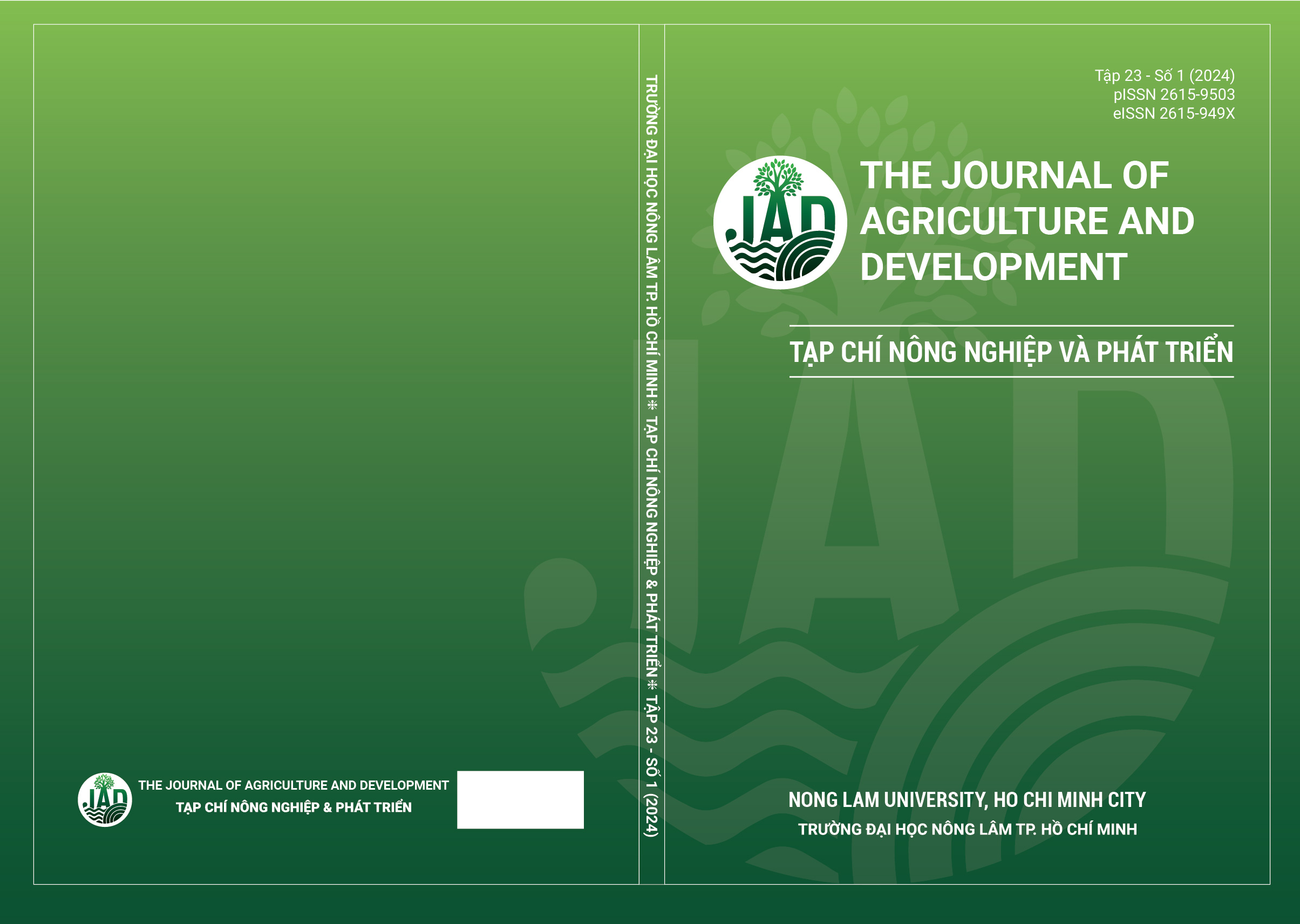Establishment and evaluation of the fluid therapy in the treatment of diseases in dogs
Main Article Content
Abstract
The objective of this study was to establish and evaluate fluid therapy for treatment of diseases in dogs. The study was conducted from 12/2022 to 05/2023 in Petcare and Nong Lam University Veterinary Hospitals, Ho Chi Minh City. The methodology involved assessing dehydration levels of 5%, 7%, 10 - 12%, & 15%, calculating the required fluid volume, and evaluating effects of fluid therapy in disease cases. A total of 251 cases included 95 cases at Petcare Veterinary Hospital and 156 cases at Nong Lam University Veterinary Hospital. The results showed that the digestive disease group had the highest rate at 63.75% in cases using fluid infusion, and the infectious diseases with the rate of 19.92%. Dehydration status of cases was most commonly observed at 5 - 10%, with the 10% level accounting for the highest rate at 37.85%, followed by 7% (29.48%), 5% (21.12%), and the 12% dehydration was the lowest rate (11.16%). The effects of fluid therapy on these cases showed a recovery rate of 67.73%, a disease remission rate of 15.14%, and a death rate of 17.13%. The average treatment duration was 6.49 days for recovery cases, 7.87 days for disease remission, and 4.49 days for death cases. The highest recovery rate was 31 - 35% at 7 - 10% dehydration levels while the death rate was as high as 55.81% at 10% dehydration. The treatment effects were high by using the fluid therapy that combined ringer lactate or saline 0.9% with glucose 5%.
Article Details
References
Aarnes, T. K., Bednarski, R. M., Lerche, P., Hubbell, J. A., & Muir, W. W. (2009). Effect of intravenous administration of lactated ringer’s solution or hetastarch for the treatment of isofluraneinduced hypotension in dogs. American Journal of Veterinary Research 70(11), 1345-1353. https://doi.org/10.2460/ajvr.70.11.1345.
Davis, H., Jensen, T., Johnson, A., Knowles, P., Meyer, R., Rucinsky, R., & Shafford, H. (2013). 2013 AAHA/AAFP fluid therapy guidelines for dogs and cats. Journal of the American Animal Hospital Association 49(3), 149-159.
DiBartola, S. P. (2011). Fluid, electrolyte, and acidbase disorders in small animal practice (4th ed.). Retrieved May 1, 2023, from htts://www.asia.elsevierhealth.com/fluid-electrolyteand-acid-base-disorders-in-small-animalpractice-9781437706543.html.
Hughston, L. (2016). The basics of fluid therapy for small animal veterinary technicians. Today’s Veterinary Technician 1(4), 22-30.
Lagutchik, M. S., Ogilvie, G. K., Hackett, T. B., & Wingfield, W. E. (1998). Increased lactate concentrations in III and injured dogs. Journal of Veterinary Emergency and Critical Care 8(2), 117-127. https://doi.org/10.1111/j.1476-4431.1998.tb00052.x.
Maddison, J. E., Church, D. B., Sajuthi, K. C., & Huynh, T. T. N. (2014). Improving skills in diagnosing dog and cat diseases (Part 1: Vomiting). Journal of Veterinary Science and Technology 21(8), 71-75.
Mazzaferro, E. (2006). Fluid therapy: The critical balance between life and death. NAVC Clinician’s Brief 2006, 73-75.
Muir, W. W., Kijtawornrat, A., Ueyama, Y., Radecki, S. V., & Hamlin, R. L. (2011). Effects of intravenous administration of lactated Ringer’s solution on hematologic, serum biochemical, rheological, hemodynamic, and renal measurements in healthy isoflurane-anesthetized dogs. Journal of the American Veterinary Medical Association 239(5), 630-637. https://doi.org/10.2460/javma.239.5.630.
Nguyen, M. T. B. (2015). Determining the need of fluid infusion in the treatment of digestive disorders in dogs at the veterinary hospital, Can Tho University. Journal of Veterinary Science and Technology 22(4), 16-23.
Pham, N. T., Ho, V. N., & Chu, D. T. (2006). Internal medicine of cattle. Ha Noi, Vietnam: Ha Noi Publishing House.
Vu, Q. N. (2003). Clinical examination in dogs and cats. Journal of Veterinary Science and Technology 20(8), 79-93.
Wanamaker, B. P., & Massey, K. (2008). Applied pharmacology for veterinary technicians (4th ed.). Missouri, USA: Elsevier.
Wellman, M. L., DiBartola, S. P., & Kohn, C. W. (2006). Chapter 1 - Applied physiology of body fluids in dogs and cats. In Dibartola, S. P. (Ed.). Fluid, electrolyte, and acid-base disorders in small animal practice (3rd ed., 3-26). https://doi.org/10.1016/B0-72-163949-6/50004-7.








